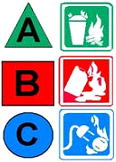Fire Extinguishers
If used correctly, fire extinguishers can be a valuable tool in protecting life and property. Fire extinguishers can completely extinguish a small fire or slow its progress until the fire department arrives. The time to learn how to use a fire extinguisher is before a fire starts. You won't have time to read the label during an emergency.
Fire Extinguisher Use
Check the label now. Your extinguisher must be rated for the type of fire or "class". Look for symbols that indicate your extinguisher's class and rating. For example, wood and paper fires require a Class A extinguisher. However, the Stockton Fire Department would recommend a rating of "2" over a rating of "1". This means a 2A extinguisher has more firefighting capability than a 1A.
Should you fight the fire? Only fight a fire if the fire is small and confined to the immediate area where it started such as a wastebasket, cushion, small appliance, or stove. and your extinguisher is rated for the type of fire you are fighting.
Proceed only if you have had training in use of the extinguisher and are confident that you can operate it effectively. If so, you must then:
-
Sound the alarm, make sure everyone has left or is leaving the building.
-
Call 9-1-1 to notify the Fire Department.
Fire Extinguisher Classes and Ratings
Extinguishers can be purchased with multiple classes and ratings.

An "A" in a green triangle is Class A for ordinary combustible materials, wood, paper, plastics, and clothing.
A "B" in a red square is Class B for flammable liquids.
A "C" in a blue circle is Class C for energized electrical equipment.
Uses and Types of Fire Extinguishers
- Water-Based - for use on Class A fires only.
- Carbon Dioxide - a clean agent type for use on Class B and Class C fires.
- Halogenated Agent - another clean agent type (Halon 1211) for use on Class B and Class C fires.
- Foam - including aqueous film-forming foam (AFFF) and film-forming fluoro protein foam (FFFP) for use on Class A and Class B fires.
- Dry Chemical - for use on Class B and Class C fires.
- K Class - for use on Class B and Class C commercial kitchen grease and oil fires.
- Multipurpose Dry Chemical - for use on Class A , Class B, and Class C fires.
- Dry Powder - for use on Class D metal fires such as powdered aluminum or sodium.
Never use an extinguisher on a fire that it is not rated for. For example, a Class A extinguisher used on a flammable liquid or energized electrical fire would be a very dangerous mistake.
Location of Fire Extinguishers
To meet the minimum requirements, you will need one 2-A:10-B:C extinguisher for each 3000 square feet or 75 feet travel distance. Hazardous occupancies must meet additional extinguisher requirements. Fire extinguishers are normally placed near exits to lessen the risk of being trapped in the building.
For additional information about fire extinguishers, please contact the Stockton Fire Department Fire Prevention Division.
External Links
This City of Stockton web page last reviewed on --- 4/26/2023
